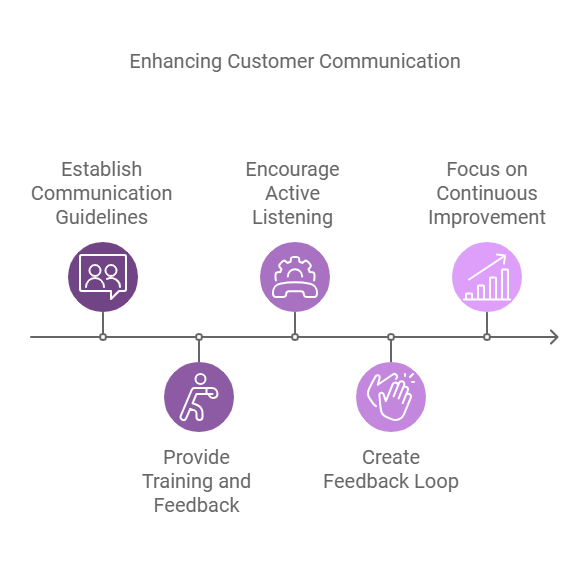Customer satisfaction is the key to any successful business. A crucial component of satisfying customers is effective communication. Poor communication, on the other hand, can have a devastating impact on your business. In this article, we will explore some common customer service communication mistakes that can lead to customer dissatisfaction and even drive customers away. We will also discuss strategies to minimize misunderstandings and improve communication with your customers.
How Poor Communication Can Lead to Customer Dissatisfaction

Imagine this scenario: you have a problem with a product or service and you reach out to customer service for assistance. However, instead of receiving prompt and helpful support, you are met with confusion and frustration. This kind of experience can leave a lasting negative impression on customers and erode their trust in your business.
Effective communication is not just about conveying information; it is about understanding the needs and concerns of your customers and addressing them in a timely and empathetic manner. When businesses fail to achieve this, they risk alienating their customers and damaging their reputations.
Lack of clarity in customer communications
One of the key reasons why poor communication can lead to customer dissatisfaction is the lack of clarity. When customers reach out to customer service, they expect clear and concise answers to their questions or solutions to their problems. However, if the communication could be clearer and more clear, it can leave customers feeling frustrated and confused. They may have to go through multiple rounds of back-and-forth communication, wasting their time and increasing their frustration levels.
Poor communication can lead to misunderstandings.
When customer service representatives fail to fully understand the customer’s issue or communicate the appropriate solution, it can result in a breakdown of trust. Customers may feel like their concerns are not being taken seriously or that the company does not value their business. This can lead to a loss of loyalty and ultimately, customers seeking alternatives from competitors who prioritize effective communication. Make sure to offer appropriate training to avoid such situations. For example, if your customer service rep is not a native speaker, make sure he or she gets access to language learning apps or courses to learn Italian, Chinese, or whatever language he or she needs.
Empathetic Tone for the Win
The tone of communication also plays a crucial role in customer satisfaction. When customers reach out for support, they expect a friendly and empathetic response. However, if the communication is cold, robotic, or lacking in empathy, it can leave customers feeling unimportant and undervalued. This can further exacerbate their dissatisfaction and push them away from the business.
Value of Customers’ Time
Another aspect of poor communication that can lead to customer dissatisfaction is the lack of timely responses. In today’s fast-paced world, customers expect quick resolutions to their problems. If they have to wait for an extended period of time to receive a response or if their inquiries are ignored altogether, it can leave them feeling neglected and frustrated. This can have a significant impact on their overall perception of the company and their willingness to continue doing business with them.
Customer Service Communication Mistakes to Avoid
Communication Mistake 1: Low FCR Rates
First Call resolution (FCR) is a critical metric that measures your ability to resolve customer issues on the first interaction. High FCR rates demonstrate efficient and effective customer service. On the other hand, low FCR rates indicate that customers are being bounced around from one agent to another, leading to frustration and dissatisfaction.
One way to improve FCR rates is by providing comprehensive training to your customer service representatives. Equip them with the necessary knowledge and tools to handle a wide range of customer inquiries. This will enable them to resolve issues quickly and efficiently, leaving customers satisfied and impressed with your service.
Communication Mistake 2: Complicated and Unhelpful Answers
When customers seek assistance, they expect clear and concise answers that address their concerns. Unfortunately, many businesses fall into the trap of using complicated language and technical jargon that only serve to confuse customers further.
Instead, strive to communicate in plain and simple language that is easily understood by your customers. Break down complex concepts into bite-sized pieces, and provide step-by-step guidance whenever necessary. This will not only help customers solve their problems but also build their confidence in your brand.
Communication Mistake 3: Irrelevant Communications to Customers
Relevance is key when it comes to effective communication. Sending irrelevant messages, promotions, or offers to customers can be irritating and make them feel like you are not paying attention to their needs.
Make sure to segment your customer base and tailor your communications accordingly. Personalize your messages based on customers’ preferences and past interactions with your business. By doing so, you will show your customers that you value their individuality and are committed to meeting their specific needs.
Communication Mistake 4: Lack of Self-Service
In the digital age, customers expect immediate access to information and self-service options. However, many businesses still fall short of providing these resources.
Investing in a comprehensive FAQ page, knowledge base, and chatbot system can significantly improve your customers’ experience. These self-service tools empower customers to find answers to their questions at any time, without the need for direct assistance. By offering self-service options, you not only improve customer satisfaction but also reduce the load on your customer service team.
Communication Mistake 5: Dismissal of Customer Feedback
Customer feedback is an invaluable resource for businesses. It provides insights into areas where you can improve and highlights potential issues that may be affecting customer satisfaction. However, many businesses make the mistake of dismissing or ignoring customer feedback, which can be detrimental to their reputation.
Make it a priority to actively listen to your customers and acknowledge their feedback. Respond promptly and address their concerns with genuine care and empathy. By demonstrating that you value their input, you can build trust, loyalty, and a positive brand reputation.
Strategies to Minimize Misunderstandings between Business and Customers

Minimizing misunderstandings requires a proactive approach to communication. Here are some strategies to consider:
- Clear Communication Guidelines: Establish clear guidelines for customer communication, including tone of voice, response time, and resolution protocols. Ensure that your customer service team is aligned with these guidelines.
- Regular Training and Feedback: Provide ongoing training to your customer service representatives to enhance their communication skills. Regularly solicit feedback from customers to identify areas for improvement.
- Active Listening: Encourage your customer service team to practice active listening. This involves showing genuine interest, asking relevant questions, and summarizing customers’ concerns to ensure full comprehension.
- Feedback Loop: Establish a feedback loop where customer feedback is collected, analyzed, and shared with relevant teams within your business. This ensures that customer concerns are addressed promptly and that improvements are made where necessary.
- Continuous Improvement: Treat communication as an ongoing process, and constantly look for ways to improve. Monitor key metrics, such as FCR rates and customer satisfaction scores, to identify areas of weakness and implement necessary changes.
By implementing these strategies, you can minimize misunderstandings, enhance communication with your customers, and ultimately build a strong and loyal customer base.
Effective communication is not just a nice to have; it is a necessity for any business that wants to thrive in today’s competitive landscape. Avoiding common customer service communication mistakes and investing in improving your communication processes can make all the difference in retaining customers, attracting new ones, and ultimately ensuring the long-term success of your business.




